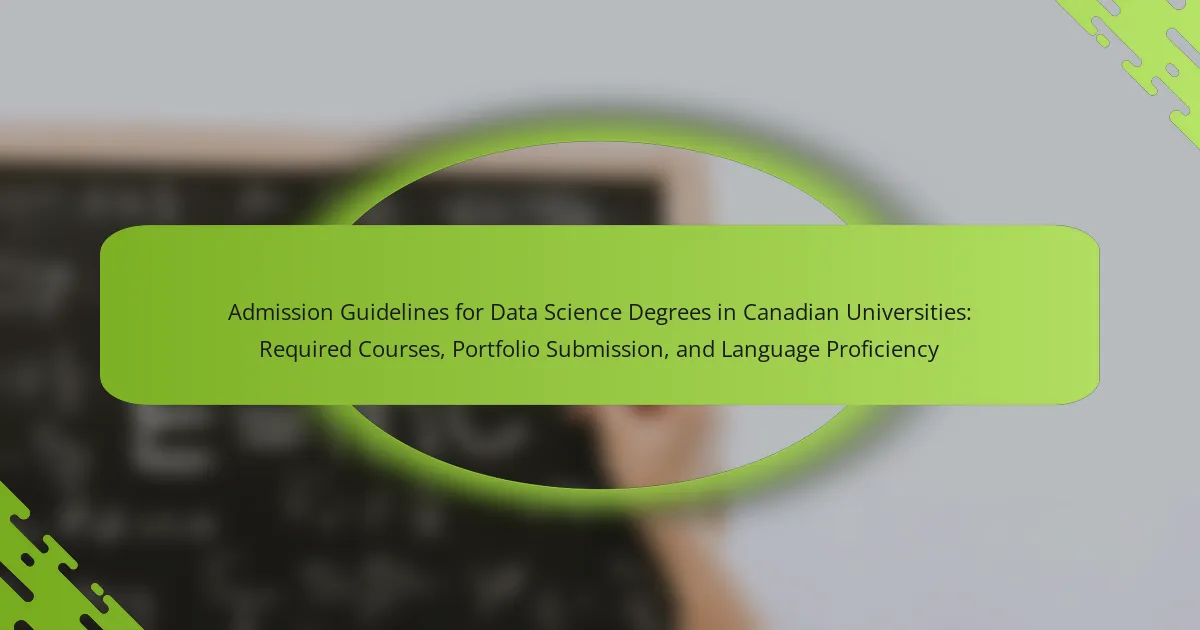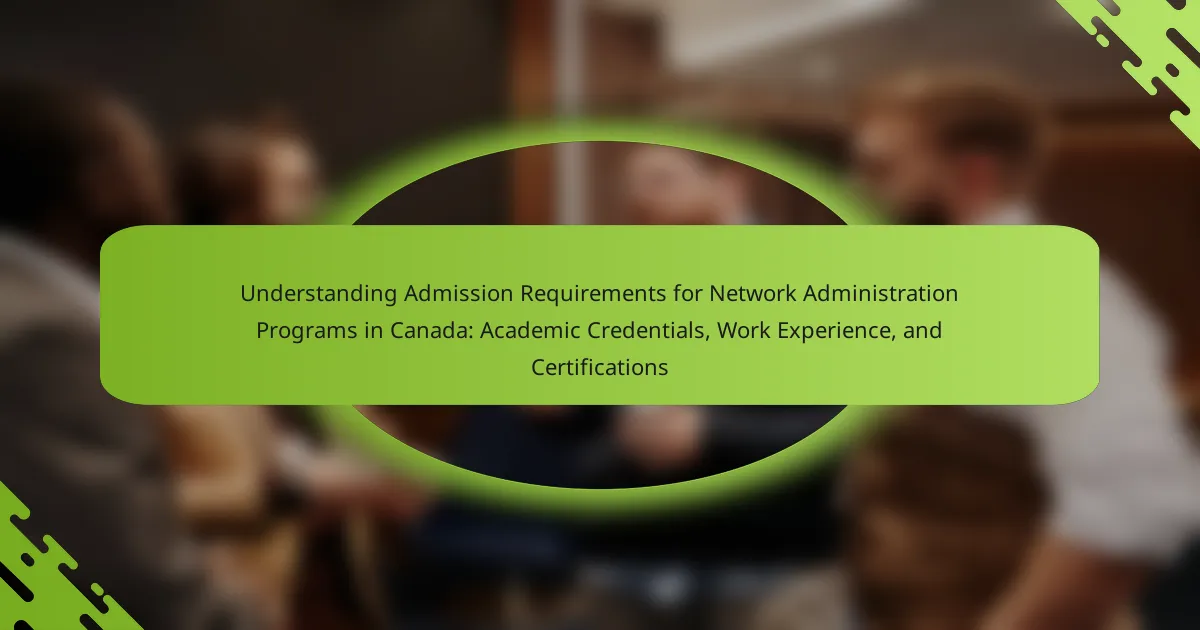Admission requirements for computer science programs in Canadian universities typically include a high school diploma, completion of specific courses such as mathematics and computer science, and a minimum average grade of around 75%. Applicants may also need to submit standardized test scores, letters of recommendation, and personal statements, with some programs requiring interviews or portfolios. The application process involves researching universities, gathering necessary documents, and submitting applications, often accompanied by entrance exams like the SAT or ACT. Strategies to enhance admission chances include maintaining a high academic average, excelling in relevant courses, gaining work experience, and preparing for entrance exams. Each university may have unique requirements, making it essential for applicants to check individual program details.

What are the Admission Requirements for Computer Science Programs in Canadian Universities?
Admission requirements for computer science programs in Canadian universities typically include a high school diploma. Applicants usually need to have completed specific courses such as mathematics and computer science. Many universities require a minimum average grade, often around 75% or higher. Standardized test scores, like the SAT or ACT, may also be requested by some institutions. Additionally, letters of recommendation and personal statements are often part of the application process. Some programs may require an interview or portfolio of work. International students may need to demonstrate English proficiency through tests like IELTS or TOEFL. Each university may have unique requirements, so it is essential to check individual program details.
What general prerequisites do students need to meet?
Students generally need to meet specific academic qualifications. Most Canadian universities require a high school diploma. This diploma should include courses in mathematics and science. Advanced courses in computer science or information technology are often recommended. Additionally, students may need to achieve a minimum grade point average (GPA). Some programs may require standardized test scores, such as the SAT or ACT. English language proficiency tests, like IELTS or TOEFL, are also commonly required for non-native speakers. Meeting these prerequisites is essential for successful admission into computer science programs.
Which high school courses are essential for admission?
Essential high school courses for admission to computer science programs typically include mathematics, physics, and computer science. Mathematics is crucial as it provides foundational skills for programming and algorithm development. Physics offers insights into problem-solving and analytical thinking, which are vital in computing. Computer science courses introduce programming concepts and computational thinking. Many universities also recommend English for communication skills. These courses align with the requirements set by Canadian universities for prospective computer science students.
What standardized tests might be required?
Standardized tests that might be required include the SAT or ACT for undergraduate admissions. These tests assess math, reading, and writing skills. Some universities may also require the GRE for graduate programs. The GRE evaluates analytical writing, quantitative reasoning, and verbal reasoning. Specific requirements vary by institution. It is essential to check individual university admission guidelines.
How do admission requirements vary across different universities?
Admission requirements vary significantly across different universities. Each institution sets its own criteria based on academic standards, program competitiveness, and regional factors. For instance, some universities may require a minimum average of 80% in high school courses, while others may accept averages as low as 75%. Specific prerequisites can also differ; certain programs may demand advanced mathematics or physics, while others may not have such requirements. Additionally, standardized test scores, like the SAT or ACT, may be mandatory at some universities but optional at others. Application deadlines can vary as well, with some universities offering rolling admissions and others adhering to fixed dates. Furthermore, additional components such as personal statements, recommendation letters, and interviews may be required by some institutions but not by others. This variability reflects each university’s unique approach to evaluating potential students.
What factors influence the selection criteria at various institutions?
Selection criteria at various institutions are influenced by academic performance, standardized test scores, and relevant experience. Academic performance includes high school grades and specific course prerequisites. Standardized test scores, such as the SAT or ACT, can also play a critical role. Relevant experience encompasses internships, projects, or work related to computer science. Additionally, letters of recommendation and personal statements can significantly impact the evaluation process. Institutions may also consider diversity and extracurricular involvement as part of their holistic review. Each institution sets its own weight for these factors based on its values and goals.
How do competitive programs differ from standard programs?
Competitive programs are designed to select a limited number of students based on stringent criteria. These criteria often include higher academic achievements, specialized skills, and relevant experience. Standard programs typically have more open admission policies with fewer restrictions. Competitive programs may require additional assessments, such as interviews or portfolios. In contrast, standard programs usually rely solely on academic transcripts for admission decisions. Statistics show that competitive programs often have acceptance rates below 20%. This indicates a higher level of selectivity compared to standard programs, which can have acceptance rates above 50%.

What is the Application Process for Computer Science Programs?
The application process for computer science programs typically involves several key steps. First, prospective students must research universities offering computer science degrees. Next, they need to gather required documents such as transcripts, letters of recommendation, and personal statements.
After preparing the documents, applicants fill out the university’s application form. Many universities require standardized test scores, such as the SAT or ACT, depending on the program. Once the application is submitted, students may need to attend an interview or complete additional assessments.
Finally, applicants await admission decisions, which are usually communicated via email or the university’s application portal. According to Statistics Canada, over 40,000 students enrolled in computer science programs in 2021, reflecting the growing interest in this field.
What steps should applicants follow during the application process?
Applicants should follow these steps during the application process for computer science programs in Canadian universities. First, they must research the specific program requirements of each university. Each institution has unique prerequisites and deadlines. Next, applicants should gather necessary documents such as transcripts, letters of recommendation, and a personal statement. These documents are essential for a complete application. After that, they need to complete the application form accurately. Many universities offer online submission options. Then, applicants should pay the application fee as required by the university. This fee varies by institution. Finally, they should submit their application before the deadline. Missing the deadline can result in disqualification from the admission process. Following these steps increases the chances of a successful application.
How do applicants submit their applications?
Applicants submit their applications online through the university’s official admissions portal. Each Canadian university has a specific portal for this purpose. Applicants must create an account to access the application form. They will fill out personal information, academic history, and program choice. Applicants may also need to upload supporting documents. Common documents include transcripts and letters of recommendation. After completing the form, applicants submit it electronically. Submission deadlines vary by university and program.
What documents are typically required for submission?
The documents typically required for submission to computer science programs in Canadian universities include academic transcripts, letters of recommendation, a statement of purpose, and standardized test scores. Academic transcripts provide proof of previous education and grades. Letters of recommendation are often from teachers or professionals who can vouch for the applicant’s abilities. A statement of purpose outlines the applicant’s goals and reasons for pursuing the program. Standardized test scores, such as the SAT or GRE, may be required by some institutions. Each university may have specific requirements, so it is essential to check their guidelines.
What are the important deadlines for applications?
Important deadlines for applications to computer science programs in Canadian universities typically fall between January and March for September intake. Specific deadlines vary by institution. For example, the University of Toronto has a deadline of January 15. McGill University requires applications by February 1. The University of British Columbia’s deadline is January 15 for international students. It is essential to check each university’s official website for exact dates and any updates. Missing these deadlines can result in the inability to apply for the desired program.
When should students start preparing their applications?
Students should start preparing their applications at least six months before the application deadlines. This timeline allows for gathering necessary documents, such as transcripts and recommendation letters. It also provides ample time to write personal statements and tailor applications to specific programs. Many Canadian universities have application deadlines between January and March for September admissions. Therefore, starting preparation in the summer or early fall is advisable. This proactive approach increases the chances of submitting a strong application. Additionally, early preparation helps students manage any unforeseen challenges that may arise.
How can applicants keep track of important dates?
Applicants can keep track of important dates by using a calendar system. Digital calendars, such as Google Calendar, allow users to set reminders for application deadlines. Physical planners can also be effective for noting key dates. Creating a timeline for the application process helps visualize deadlines. Many universities provide a list of important dates on their websites. Applicants should regularly check these resources for updates. Setting alerts on mobile devices ensures timely notifications. This proactive approach minimizes the risk of missing critical deadlines.

What strategies can enhance the chances of admission?
To enhance the chances of admission to computer science programs in Canadian universities, applicants should focus on several key strategies. First, maintaining a high academic average is crucial. Many programs require a minimum average, often around 75% or higher in relevant courses. Second, strong performance in mathematics and science courses is essential, as these subjects form the foundation of computer science. Third, obtaining relevant work experience or internships can significantly improve an applicant’s profile.
Additionally, crafting a compelling personal statement is important. This document should clearly express the applicant’s passion for computer science and outline their career goals. Securing strong letters of recommendation from teachers or professionals in the field can also bolster an application.
Finally, preparing thoroughly for any required entrance exams, such as the SAT or ACT, can further enhance admission prospects. Research shows that applicants who follow these strategies are more likely to be accepted into competitive programs.
How can students strengthen their applications?
Students can strengthen their applications by enhancing their academic performance. A high GPA demonstrates strong academic capabilities. Participation in relevant extracurricular activities showcases commitment and passion for computer science. Obtaining strong letters of recommendation from teachers or professionals adds credibility to the application. Completing advanced coursework, such as AP or IB classes, signals readiness for university-level challenges. Gaining practical experience through internships or projects provides real-world skills. Crafting a compelling personal statement allows students to express their unique perspectives and aspirations. Finally, preparing thoroughly for standardized tests can improve overall application competitiveness.
What role do recommendation letters play in the application process?
Recommendation letters provide insight into an applicant’s qualifications and character. They are typically written by teachers, employers, or mentors who can attest to the applicant’s skills. These letters help admissions committees assess the applicant’s potential for success in a computer science program. They often highlight the applicant’s academic abilities, work ethic, and interpersonal skills. Strong recommendation letters can differentiate an applicant in a competitive field. Studies show that personal endorsements significantly influence admission decisions. For example, a survey by the National Association for College Admission Counseling indicates that recommendation letters are a key factor in evaluating candidates.
How can personal statements impact admission decisions?
Personal statements significantly influence admission decisions by providing insight into an applicant’s motivations and character. They allow candidates to showcase their unique experiences and perspectives. Admissions committees often use personal statements to assess fit for the program. A well-crafted personal statement can highlight relevant skills and achievements. It can differentiate applicants with similar academic qualifications. Research indicates that personal statements account for a considerable portion of the holistic review process. This process evaluates not just grades but also personal qualities and potential contributions to the university community. Therefore, a compelling personal statement can enhance an applicant’s chances of acceptance into competitive programs.
What common mistakes should applicants avoid?
Applicants should avoid submitting incomplete applications. Incomplete applications can lead to automatic disqualification. They must ensure all required documents are included. Missing transcripts or letters of recommendation are common issues. Applicants should also avoid generic personal statements. Tailoring statements to specific programs shows genuine interest. Failing to follow application guidelines is another mistake. Each university has unique requirements that must be met. Lastly, applicants should avoid procrastination. Late submissions can result in missed opportunities.
How can applicants ensure their application is complete and accurate?
Applicants can ensure their application is complete and accurate by carefully reviewing all required documents. They should cross-check their application against the specific requirements outlined by the university. This includes verifying transcripts, letters of recommendation, and personal statements. Applicants must also confirm that all forms are filled out correctly. Double-checking for spelling and grammatical errors is essential. Utilizing a checklist can help applicants track completed items. Seeking feedback from peers or mentors can provide additional insights. Finally, submitting the application well before the deadline allows time for any necessary revisions.
What are the pitfalls of waiting until the last minute to apply?
Waiting until the last minute to apply can lead to several significant pitfalls. First, applicants may miss crucial deadlines, resulting in disqualification from the program. Second, last-minute applications often lack thorough preparation, which can weaken the quality of submitted materials. Third, technical issues may arise, such as website crashes or submission errors, preventing successful application completion. Fourth, applicants miss the opportunity to seek guidance or feedback on their application, which can enhance its strength. Additionally, waiting can limit options for financial aid or scholarships, as many funds have early deadlines. Lastly, stress and anxiety levels increase when rushing to complete applications, potentially affecting performance. These pitfalls highlight the importance of timely application submissions to ensure a successful admission process.
What resources are available for prospective students?
Prospective students have access to various resources to assist with their applications. These resources include university websites that provide detailed information on admission requirements. Many universities offer virtual tours and open houses to give insights into campus life. Additionally, academic advising services are available to help students understand prerequisites. Online forums and social media groups can connect prospective students with current students. Financial aid offices provide information on scholarships and funding options. Lastly, standardized test preparation materials are often available to help students prepare for required exams.
Where can students find information about specific programs?
Students can find information about specific programs through university websites. Each university typically has a dedicated section for academic programs. This section includes detailed descriptions of the programs offered. Additionally, program-specific brochures and course outlines are often available for download. Students can also contact academic advisors for personalized guidance. Furthermore, attending university open houses provides firsthand information about programs. Online forums and student groups can offer insights from current students. Lastly, education fairs often feature representatives from various universities, providing program information directly.
How can mentorship or guidance improve the application experience?
Mentorship or guidance can significantly enhance the application experience for prospective students. Mentors provide personalized advice tailored to individual strengths and weaknesses. This targeted support helps applicants understand program requirements more clearly. Guidance can also offer insights into the application process, reducing confusion and anxiety. Furthermore, mentors can share valuable tips for crafting compelling personal statements and preparing for interviews. Research indicates that students with mentors are more likely to submit higher-quality applications. A study by the National Mentoring Partnership found that mentored students are 55% more likely to enroll in college. This statistic underscores the positive impact of mentorship on the overall application experience.
The main entity of this article is the admission requirements for computer science programs in Canadian universities. It provides a comprehensive overview of the prerequisites needed for prospective students, including necessary high school courses such as mathematics and computer science, GPA expectations, and standardized test scores like the SAT or ACT. The article details the application process, emphasizing the importance of gathering required documents, adhering to deadlines, and crafting strong personal statements and recommendation letters. Additionally, it highlights the variability in admission criteria across different institutions and offers strategies to enhance applicants’ chances of acceptance.



